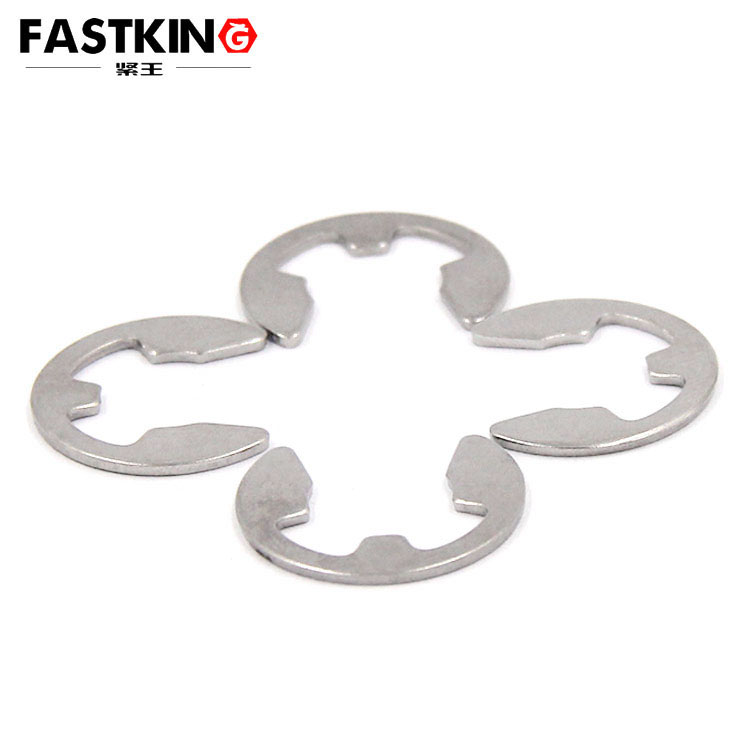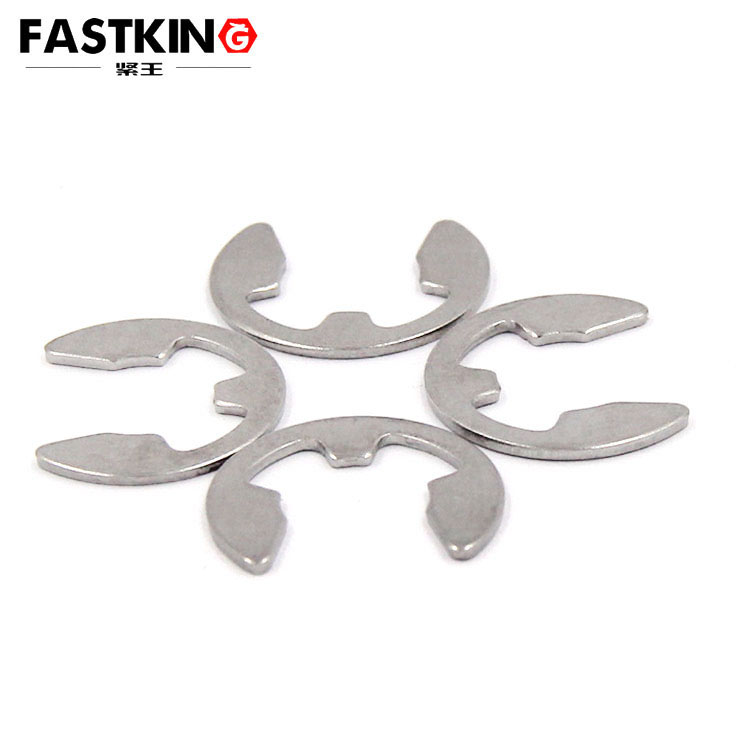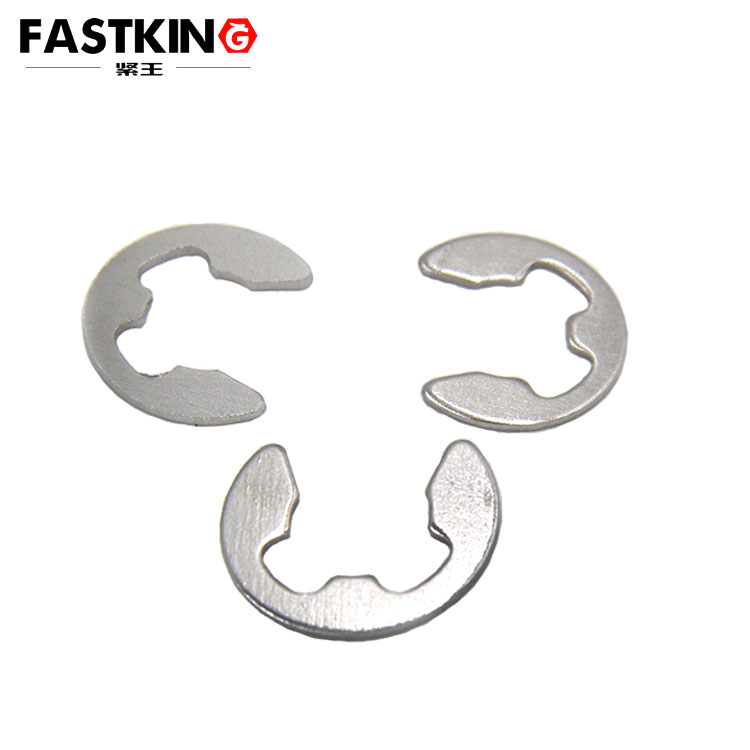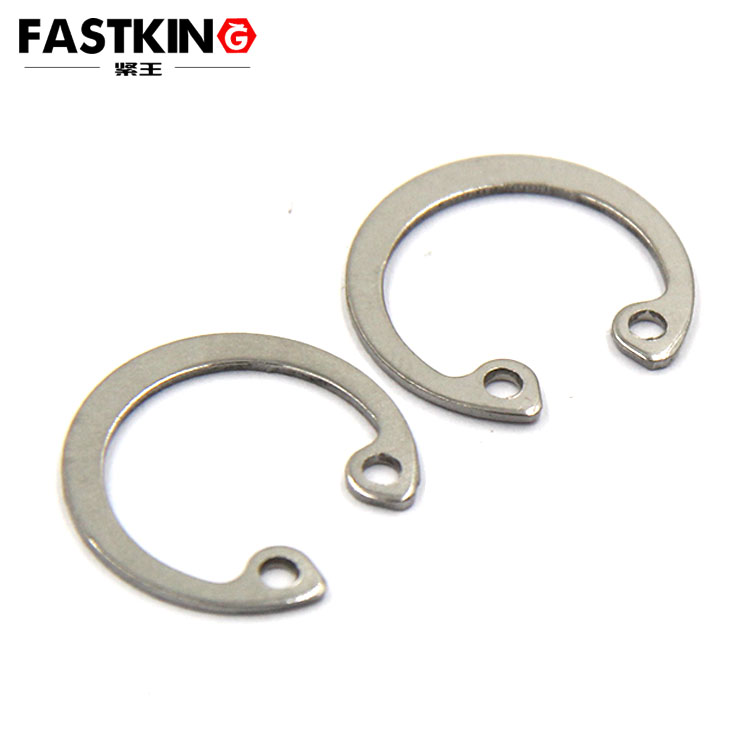- ZHUHAI JIALI HARDWARE CO.,LTD.
- 0760-85889089
DIN6799 Open Retaining Ring E Ring
- Product description:DIN6799 Open Retaining Ring E Ring
|
|
|
|
Product Name
|
DIN6799 Open Retaining Ring E Ring
|
|
Material
|
Carbon Steel, Alloy Steel, stainless steel, brass, Al, etc
|
|
Finish
|
The original color,Zinc Plated,black oxide
|
|
MOQ
|
1000 PCS
|
|
Packing
|
bulk in cartons (25kg Max.)+wood Pallet or according to customer special demand
|
|
Mode of transport
|
Express/Air/Sea
|
Open buckles are mostly made of plastic (such as nylon 66, PP) or elastic metal (such as spring steel). Their core structure is a ring or U-shape with an opening, and they achieve "snap-fit fixation" through elastic deformation at the opening. The essence of their design lies in "low assembly resistance + high fit":
-
Open buckles made of plastic are lightweight (the weight of a single buckle is usually less than 1g) and low-cost, making them suitable for lightweight, non-corrosive indoor scenarios, such as fixing internal wire harnesses in home appliances. Between the circuit boards and casings of refrigerators and air conditioners, nylon open buckles can be snapped into the wire harness slots through elastic deformation, fixing the wire harnesses neatly and preventing displacement and wear of the wire harnesses due to equipment vibration.

- Open buckles made of metal, with higher strength, are suitable for axial positioning of small components. For example, when fixing the bearing end cover of a micro-motor, the barb structure at the opening of the buckle is not easy to fall off after snapping, ensuring a tight fit between the end cover and the motor casing.
Such buckles have strong adaptability. Their opening width and ring inner diameter can be customized according to the size of the fixed part (such as wire harness diameter, component thickness), and no tools are required for installation. Workers only need to pinch the two ends of the opening with their fingers to deform it, then fit it into the target position, and release it— the buckle will return to its original shape by elasticity to complete the fixation. However, their limitations are also obvious: plastic buckles have poor temperature resistance (usually ≤120℃) and cannot be used in high-temperature scenarios; metal buckles need to avoid corrosive environments to prevent loss of fixation due to elastic attenuation.
Open Retaining Rings: "Annular Positioning Guardians" for Shaft Components
Open retaining rings, also known as "open elastic retaining rings", are mostly made of spring steel or stainless steel (304/316). Their structure is a ring with a single opening, and the edge of the ring is often designed with anti-slip protrusions or chamfers. Their core function is "axial positioning of components on the shaft".
Compared with closed retaining rings, the open design allows them to be laterally snapped into the pre-set annular groove on the shaft through elastic expansion at the opening, without being slipped from the shaft end. This greatly simplifies the assembly process— especially in scenarios where other components (such as gears, bearings) have been pre-installed on the shaft, open retaining rings can be installed without disassembling the existing components, significantly improving assembly efficiency.

The application of open retaining rings is most typical in the automotive transmission system: the sliding gear on the drive shaft needs to move axially to achieve gear shifting, and a stainless steel open retaining ring is installed in the pre-set annular groove on the shaft. The retaining ring fits closely to the groove wall through its own elasticity, which not only limits the maximum movement stroke of the gear but also prevents radial wobble when the gear slides. On the motor shaft of power tools (such as electric drills, electric saws), open retaining rings are used for bearing positioning to prevent the bearing from moving axially due to axial force during high-speed operation of the motor, ensuring transmission accuracy.
When selecting open retaining rings, focus should be placed on their "opening gap" and "thickness": an excessively large opening gap may cause looseness after installation, while an excessively small one may increase assembly difficulty; the thickness needs to match the depth of the annular groove on the shaft to ensure the retaining ring does not protrude from the shaft surface after installation, avoiding interference with other components.
Open Circlips: "Elastic Positioning Experts" for High-Precision Scenarios
Open circlips (also known as "shaft-mounted open washers") are the most precise among the four types of components. They are produced in strict accordance with national standards (such as GB/T 894.1), mainly made of spring steel or stainless steel. Their structure is a thin ring with an opening, and the edge of the ring is precision-ground— the thickness tolerance can be controlled within ±0.02mm. Their core function is "high-precision axial positioning".
Compared with open retaining rings, the differences mainly lie in "thinner thickness" and "higher positioning accuracy". The thickness of open circlips is usually only 0.5-2mm, making them suitable for scenarios with compact space and strict requirements for positioning accuracy, such as precision transmission components in medical equipment. On the drive shaft of dental handpieces (high-speed turbine drills), open circlips are used to position turbine blades. The fit gap between the blades and the drive shaft is only 0.01-0.03mm, and the high-precision thickness of the circlip ensures the blades do not get stuck due to excessive thickness of the circlip, nor lose positioning due to insufficient thickness.
Open circlips are also indispensable in the industrial motor field: between the rotor shaft and end cover of a servo motor, after the circlip is snapped into the shaft groove, the axial movement of the rotor can be controlled within 0.05mm, ensuring the dynamic balance performance of the motor during operation and avoiding noise and vibration caused by movement. Special circlip pliers (internal straight-mouth or external straight-mouth) are required for installation— the pliers are used to expand the opening of the circlip and snap it into the pre-set groove. Although special tools are needed, their positioning accuracy is much higher than that of ordinary open retaining rings, making them the "preferred positioning components" for high-precision equipment.
Open Stop Clips: "Strong Blocking Components" for Heavy-Duty Scenarios
Open stop clips (also known as "open washers" or "heavy-duty open clips") are the strongest among the four types of components. They are mostly made of high-strength alloy steel (such as 65Mn, chrome-vanadium steel), and their hardness can reach HRC45-55 after heat treatment. Their core structure is a thick-walled ring with an opening, and the two sides of the ring are often designed with reinforcing ribs; some models are also equipped with lugs to facilitate applying external force during installation. Their core function is "axial blocking of heavy-duty components".
Compared with the previous three types of components, their notable features are "strong load-bearing capacity" and "good impact resistance", making them suitable for heavy-duty scenarios with large loads and severe vibration, such as hydraulic cylinders of construction machinery. An open stop clip needs to be installed on the piston rod of the oil cylinder to block the maximum stroke of the piston and avoid hard collision between the piston and the cylinder bottom. The thick-walled structure and reinforcing ribs of the stop clip can withstand axial impact forces of hundreds of kilograms and are not easy to deform or break during long-term use.
Open stop clips also play a key role in the automotive chassis field: on the piston rod of the shock absorber in the suspension system, the stop clip is elastically snapped into the shaft groove through the opening to limit the telescopic stroke of the shock absorber. Even when the vehicle is driving on bumpy roads, the stop clip can resist frequent impacts and ensure the stable operation of the shock absorber.
When selecting such stop clips, focus should be on "load-bearing capacity" and "corrosion resistance": for heavy-duty scenarios, thick-walled models with reinforcing ribs should be selected; for coastal or humid environments, galvanized or stainless steel materials should be used to prevent strength reduction due to rust.
Although open buckles, open retaining rings, open circlips, and open stop clips all belong to "open elastic fasteners", their applicable scenarios are distinctly different:
- In terms of materials: plastic open buckles are suitable for lightweight, low-cost scenarios; metal types (retaining rings, circlips, stop clips) are suitable for high-strength scenarios.
- In terms of precision: open circlips have the highest precision, open stop clips have the strongest strength, while open buckles and retaining rings focus more on convenience.
- In terms of installation methods: open buckles can be installed by hand, circlips require special tools, and stop clips often need to be assisted by wrenches.
In industrial assembly, although these four types of components are small in size (the maximum outer diameter is usually no more than 50mm), they undertake the important mission of "precision positioning". Without them, motor bearings may move, automotive drive shafts may shift, and home appliance wire harnesses may become disordered. As the manufacturing industry moves towards "precision" and "lightweight", such open elastic fasteners are also constantly upgrading: high-temperature resistant materials (such as PPS) are introduced into plastic buckles to adapt to high-temperature scenarios; laser cutting is used for metal circlips to improve precision; anti-corrosion coatings are added to stop clips to extend their service life. In the future, they will continue to provide reliable support for "micro-fixation" in industrial assembly with better performance and more precise adaptability.


